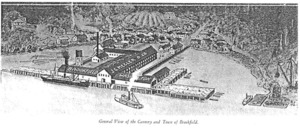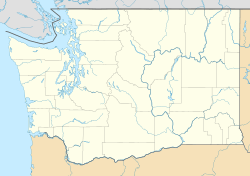Brookfield, Washington facts for kids
Quick facts for kids
Brookfield, Washington
|
|
|---|---|

Impression of Brookfield, 1926
|
|
| Country | United States |
| State | Washington |
| County | Wahkiakum |
| Established | 1873 |
| Elevation | 20 ft (6 m) |
| Population
(1900)
|
|
| • Total | 479 (peak) |
| Time zone | UTC-8 (Pacific (PST)) |
| • Summer (DST) | UTC-7 (PDT) |
| GNIS feature ID | 1510839 |
Brookfield was a small town in Washington state. It was a busy place for catching and canning salmon. The town existed from 1873 to 1957. It was located on the Columbia River in Wahkiakum County, Washington. Brookfield was also home to a big company called the J.G. Megler Company. Today, Brookfield is a ghost town, meaning it no longer exists.
Contents
The Story of Brookfield
Brookfield was started in 1873. A man named J.G. Megler built a salmon cannery there. A cannery is a factory where fish are put into cans. It was built in a calm bay on the Columbia River. Megler named it "Brookfield Fisheries." This name came from his wife's hometown in Massachusetts. The Brookfield post office opened in 1874. J.G. Megler was the first postmaster.
Life in the Fishing Town
Most people in Brookfield worked at the cannery. Many were fishermen who supplied the cannery. The J.G. Megler Company brought Croatian fishermen to live and work there. These families became a big part of Brookfield. The company also hired Chinese workers. They came seasonally to help with the canning.
Around 1880, the Finke Brothers opened a barrel factory. Barrels were important for shipping fish. This factory was also in Brookfield. It burned down in 1923. The brothers then moved their business away.
School Days in Brookfield
The first school in Brookfield opened in 1888. It was a small, one-room school. Around 1924, a new school was built. This one had two rooms. A second teacher was also hired. This shows the town was growing.
A Busy River Port
The large salmon cannery had many docks. It was the main building in the bay. The Megler Mansion was a huge house. It sat on a ridge overlooking the town. From there, you could see across the Columbia River. The mansion's gardens had trees from every U.S. state. Important visitors often brought them as gifts.
Houses lined a road around the bay. This road led to a valley behind the town. Brookfield could only be reached by boat. It was a regular stop for ferries. These ferries traveled from Astoria, Oregon to Portland.
The End of an Era
After many successful years, the cannery began to decline. It burned down on July 17, 1931. The cannery was never rebuilt. With no more salmon canning, families started to leave. By the late 1930s, only a few families remained. The school stayed open until 1945.
In 1951, a company called Crown Zellerbach bought the land. They bought it for its timber (trees). This logging company built a road into Brookfield. This road finally connected the town to state roads. The post office closed on September 30, 1954. Only three families lived there at that time. In 1957, Crown Zellerbach cleared the town. They used bulldozers to remove the buildings. This was done to protect the timber from fire.
In 2017, some local names were changed. Jim Crow Point became Brookfield Point. Jim Crow Creek was renamed Harlows Creek.
Where Brookfield Was Located
Brookfield was in a bay on the north side of the Columbia River. Brookfield Point protected it from Pacific storms. Harlows Creek was on the east side. This creek also gave the town fresh water. A small dam and pipes brought the water to the town.
The bay once had a wide sandy beach. It was easy for boats to reach deep water. The J.G. Megler cannery dock made this possible. Later, Crown Zellerbach changed the bay. They filled part of it to create a log dump. This was a place to store logs. Even later, dirt from the Columbia River was piled up. These piles created large hills. People used them for four-wheeling.
How Many People Lived There
| Historical population | |||
|---|---|---|---|
| Census | Pop. | %± | |
| 1880 | 196 | — | |
| 1900 | 479 | — | |
| 1910 | 361 | −24.6% | |
| 1920 | 241 | −33.2% | |
| 1930 | 90 | −62.7% | |
| 1940 | 24 | −73.3% | |
| U.S. Decennial Census | |||
Brookfield's population changed a lot each year. This was because of the salmon canning business. More people lived there during summer and fall. These were the busy canning months. Seasonal workers would move to town then. The census numbers show these changes. For example, the 1920 numbers likely show only permanent residents. They do not include temporary workers.
The people living in Brookfield also changed over time. In 1880, many Chinese cannery workers lived there. Later, many fishermen from Austria-Hungary moved to the town.


